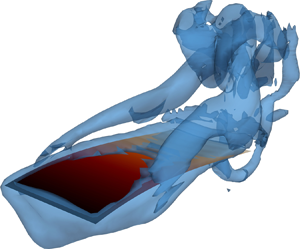Article contents
Efficient aquatic locomotion using elastic propulsors with hybrid actuation
Published online by Cambridge University Press: 12 July 2021
Abstract

Using computational modelling, we probe the hydrodynamics of a bio-inspired elastic propulsor with hybrid actuation that oscillates at resonance in a Newtonian fluid. The propulsor is actuated by a heaving motion at the base and by an internal bending moment distributed along the propulsor length. The simulations reveal that by tuning the phase difference between the external and internal actuation, the propulsor thrust and free-swimming velocity can be regulated in a wide range while maintaining high efficiency. Furthermore, the hybrid propulsor outperforms propulsors with either of the actuation methods. The enhanced performance is associated with the emerging bending pattern maintaining large tip displacement with reduced centre-of-mass displacement. The results are useful for developing highly efficient robotic swimmers utilizing smart materials as propulsors with simplified design and operation.
Information
- Type
- JFM Papers
- Information
- Copyright
- © The Author(s), 2021. Published by Cambridge University Press
References
REFERENCES
- 5
- Cited by


